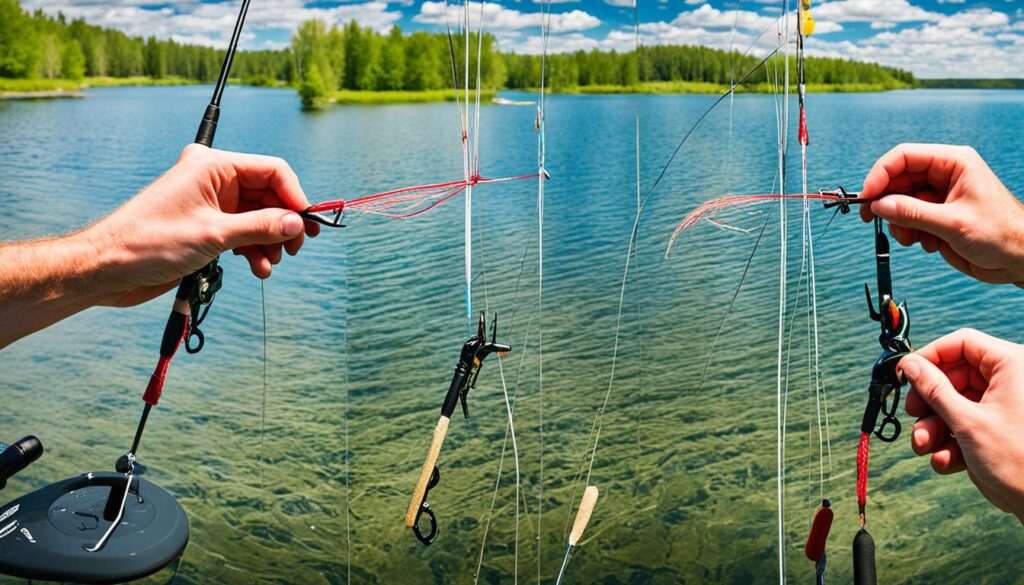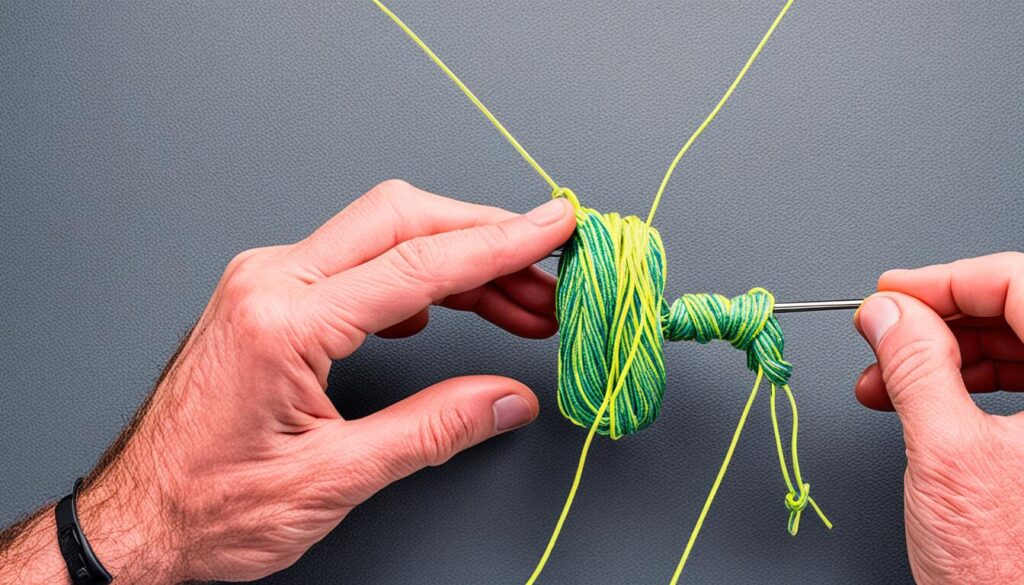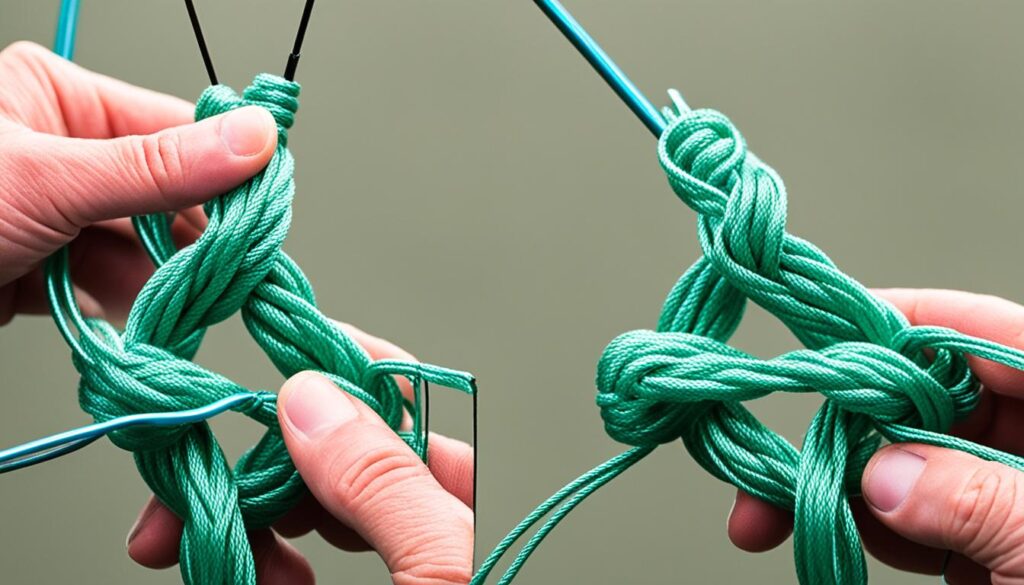Are you ready to elevate your fishing game? One crucial skill for all anglers is the Improved Clinch Knot. This solid knot is ideal for tying your main line to hooks or lures. Mastering it will boost your confidence when landing big fish. We’ll guide you through how to tie the Improved Clinch Knot step by step, making it easy and quick.
Key Takeaways:
- Learn how to tie the Improved Clinch Knot for secure and reliable connections
- Follow step-by-step instructions to master this essential fishing knot
- Considerations and tips for tying the Improved Clinch Knot for optimal performance
- Troubleshooting common issues and potential solutions
- Explore additional resources to expand your knot tying and fishing knowledge
Understanding the Steps of the Improved Clinch Knot
Tying the Improved Clinch Knot is straightforward and becomes easier with practice. Follow these steps to master it:
- Feed the line end through the hook eye or jighead
- Wrap the tag end around the main line 4-5 times
- Pass the tag end through the initial loop above the hook eye
- Pull the tag end through the second loop formed
- Tighten the knot by pulling the main line and tag end in opposite directions
- Trim the tag end, leaving a small line for security
Tips and Considerations for Tying the Improved Clinch Knot
Key points for mastering this handy fishing knot:
Choose the Right Line
- Best with monofilament or fluorocarbon lines
- Not recommended for braided lines due to slickness
Practice Makes Perfect
- Regular practice improves skill and knot strength
- Expect improvement over time
Wet the Line
- Wetting the line before tightening improves knot strength and longevity
- Creates a smoother tightening process
Regularly Inspect Your Knot and Line
- Check for line wear and knot flaws before fishing
- Early detection prevents breaks during fishing trips
Understanding the Improved Clinch Knot
Knowing how to tie the Improved Clinch Knot is a crucial skill for anglers, offering a reliable way to secure hooks or jigs. Here’s how to master it. Begin by feeding the end of your line through the hook eye or jighead. Next, wrap the tag end around the main line four to five times. Pass the tag end through the initial loop above the hook eye, then pull it through the second loop that forms. Tighten the knot by pulling the main line and tag end in opposite directions. Finally, trim the tag end, leaving a small length for security.
Please take a look at these tips to perfect your knot. First, could you choose the right line: monofilament or fluorocarbon lines work best, while braided lines are too slick for this knot. Regular practice is essential, improving skill and knot strength over time. Wetting the line before tightening enhances the knot’s stability and longevity, ensuring smoother tightening. Lastly, please check your knots regularly for line wear and flaws to ensure you don’t have breakages during fishing trips.

Additional Resources for Knot Tying and Fishing Techniques
Enhance your fishing skills with these valuable resources:
Explore Online Videos
- Visit platforms like YouTube for extensive fishing tips
- Search “fishing knots tutorial” for visual demonstrations
- Learn new skills through step-by-step video guides.
Consult Books and Guides
- Utilize fishing knot books and guides for in-depth learning
- Find clear illustrations and explanations
- Available at bookstores or online retailers
- Perfect for self-paced learning
Visit Local Fishing Stores
- Connect with experienced anglers at nearby shops
- Get hands-on demonstrations of knot tying
- Receive personalized fishing advice
- Don’t hesitate to ask questions and learn more
Key Benefits:
- Improve your fishing techniques
- Learn at your own pace
- Access both visual and written instructions
- Gain insights from experienced anglers
- Enhance overall fishing enjoyment
By leveraging these resources, you’ll expand your knot tying skills and fishing knowledge, leading to more successful and enjoyable fishing experiences.

Conclusion
Congratulations on mastering the Improved Clinch Knot! With practice, you’ll tie this essential fishing knot swiftly and securely, ensuring a strong connection between your leader line and hooks or jigheads. Remember to:
- Double-check your knot before casting
- Regularly inspect your line for wear and tear
- Maintain your fishing gear for reliability
Key takeaways:
- The Improved Clinch Knot is crucial for successful fishing
- Regular practice leads to faster, more secure knot tying
- Proper gear maintenance enhances fishing confidence
By mastering this knot and following these tips, you’re now equipped to:
- Improve your fishing technique
- Increase your catch rate
- Enjoy more successful fishing trips
Thank you for learning the Improved Clinch Knot with us. We hope this guide has provided valuable insights to enhance your fishing experience. Armed with this new skill, it’s time to head out and catch your next big fish!
Happy fishing, and may your lines always be tight!
FAQ
What is the Improved Clinch Knot?
The Improved Clinch Knot is a strong knot for attaching your leader line to hooks or jigheads. Anglers like it because it’s both fast and secure.
How do I tie the Improved Clinch Knot?
To tie the Improved Clinch Knot, do the following:
- Feed the line’s end through the hook or jighead’s eye.
- Wrap the tag end around the main line 4-5 times.
- Pass the tag end through the first loop above the eye.
- Then, pull it through the big loop that was just made.
- Finally, tighten the knot by pulling both ends. Trim the extra tag end.
What considerations should I keep in mind when tying the Improved Clinch Knot?
When tying this knot:
- Use monofilament or fluorocarbon, not braided lines.
- Practice tying it for speed and accuracy.
- Wet the line before pulling tight to strengthen the knot.
- Always check for any wear or damage before fishing.
What can I do if the Improved Clinch Knot comes loose?
If it loosens:
- Make sure it is tied tightly.
- Check that the tag end is tight and through the right loops.
- Think about using the Palomar Knot for more strength.
Where can I find additional resources for learning knot tying and fishing techniques?
To learn more, try:
- Online videos like those on YouTube.
- Books and fishing guides.
- Visiting local fishing stores for tips from experienced anglers.
What is the conclusion regarding the Improved Clinch Knot?
The Improved Clinch Knot is both versatile and trustworthy. With a little practice, tying it becomes quick and easy. Always remember to check your knots before fishing trips.
